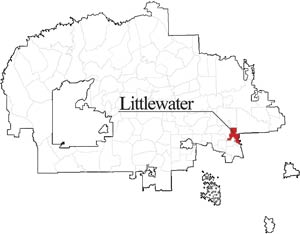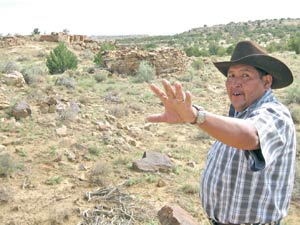The epicenter
Littlewater residents would just as soon forget their chapter's claim to fame
By Cindy Yurth
Tséyi' Bureau
LITTLEWATER, N.M., July 25, 2013
(Editor's note: In an effort to chronicle the beauty and diversity of the Navajo Nation, as well as its issues, the Navajo Times has committed to visiting all 110 chapters in alphabetical order. This is the 45th in the series.)


S o far, every chapter we've visited for this series has a toehold in history.
But Littlewater Chapter would just as soon slip out of theirs.
There is but one time multiple national news crews descended on this tiny settlement of about 2,000 people, and that was in 1993, when it was the epicenter of the hantavirus epidemic.
In fact, before researchers realized the symptoms mimicked those suffered by UN troops along the Hantaan River in North Korea in the 1950s, they were calling the pathogen "Littlewater Virus."
There are plenty of people around who remember those days well, including the chapter's Pentecostal pastor, Harry Largo.
"We lost a lot of people," Largo said. "Everyone from children to middle-aged."
Almost 85
Eighty-four people died of hantavirus in New Mexico — about 80 percent of those who contracted the disease — and Largo almost made it 85.
Largo had already lost a niece and her husband (who died on the way to her funeral), so when he started feeling headachy after working on an old chidí in his yard, he suspected the worst.
But he was due to marry his college sweetheart, Rebecca, in a week, and he figured he would hold out until his wedding and then check himself into the Indian Health Service hospital in Crownpoint, N.M.
Two days before his wedding day, however, he couldn't get up. He was rushed to Crownpoint, where the doctors took one look at him and flew him to Albuquerque.
"They told me I waited too long," Largo recalled, "and that I probably wouldn't make it."
A promise to Jesus
Largo thought of his beautiful Rebecca, and all the plans they had made. He wasn't a praying man at that time, but he knew how to pray. His grandmother was pastor of the little Pentecostal church.
Largo told Jesus that if he pulled through, he would turn over his life to God.
It took 30 long days in the hospital, days of almost constant pain and a suffocating feeling, but Largo recovered. And he was as good as his word.
He married Rebecca, got ordained and started preaching in Fruitland, N.M. While preaching at a revival in Bluff, Utah, he says he got a strong message to come home. He found the little church closed, his aging grandmother overwhelmed. Within a few days, she handed the keys to him.
So the virus was bittersweet for Largo. He almost lost his life, but he gained a calling.
'No such thing'
Other Littlewater residents get understandably angry when one brings up the epidemic. They resent the fact that their beautiful chapter, with a sacred spring and a proud history as the birthplace of the Kinyaa'aanii Clan, will be forever associated with the outbreak of a deadly disease.
Then there are those, like Herbert Enrico, who don't believe in the virus.
"Hantavirus!" he snaps. "There's no such thing."
Researchers say rodent feces spread the virus, but Enrico is having none of it.
"We lived with all these animals for years and years, and never got sick," he says. "This sickness is something the white man brought to us."
Enrico thinks the pulmonary problems blamed on the virus are actually attributable to the weapons testing the U.S. government did at Fort Wingate.
"Who knows what's been falling on us all these years?" he asked rhetorically. "That could make you sick, couldn't it?"
Patchworked land
We're not here to argue about the origin of the hantavirus. We have come to Enrico's tidy ranch in the foothills of a rocky mesa because the namesake of Littlewater Chapter, Littlewater Springs, is on his family's allotment.
Enrico, a member of the land board, explains that there are 12 kinds of land in Littlewater chapter – tribal trust, Indian allotments, private and various kinds of state and federal. The wide variety of clearances the chapter needs to get for any kind of project virtually hamstrings it, although it is making progress as it is getting basics like water and power to the people.
Enrico himself is an allottee – along with all his great-grandfather's descendants, who each inherited an interest in the land allotted to their ancestor. He's not even sure how many of his relatives have a stake in the land. Rather than trying to track them all down and get them to agree on how to use it, he has built his cattle, sheep and goat operation next door on tribal trust land.
"It's actually easier to go through all the tribal clearances than to get the allotment holders to agree on anything," he says.
The allotment may be a prime candidate for the coming Cobell settlement buyback of fractionated land interests, but that might be a shame too.
One thing good about this allotment, so fractionated that no one is really using it, is that the gorgeous sacred spring that gives Littlewater its name has hardly been developed.
A sacred spring
Enrico leads this reporter on a hike down to the spring on the condition I not photograph it. A thick layer of yellowish sandstone filters a seep of cool, clear water, hemmed into a cistern by a manmade rock wall. Chiseled into the sandstone are dozens of petroglyphs, not Anasazi but unmistakable Navajo yei bichei designs with square heads and kiltlike breechcloths.
Enrico reveals that early Diné carved the designs into the rock to let people know that this was a sacred place. When the water flows over the rock, Enrico says, the petroglyphs change color.
Two overflow holes allow excess water to escape into an intricate system of stone catchbasins, which Enrico says were built by his ancestors and others between 1900 and the 1930s.
"We didn't need the Europeans to come and tell us about conservation projects," he says haughtily. "We were already doing it."
But the terraces have lain idle a long time, and are falling apart. Enrico shows me grass roots exposed by the spring's steady winds, and says that today, the only way the chapter can prevent a drought disaster is by everyone voluntarily cutting down their herds.
A feral livestock roundup, he says, would be exceedingly difficult to organize because of the intricate land ownership pattern.
In the meantime, God seems to be finally smiling on this ill-starred chapter. Not only did he spare Largo 20 years ago but three weeks ago, he finally unleashed the monsoon.
"We did a ceremony," Enrico confides. "We brought water from here, from Florida, from Los Angeles and way up in Washington. The next day, there was a pour, and it's been raining almost every day since."
His brother, James Enrico, confirms this.
"I saw the people gathered to pray at Herbert's place," he says, "and the next day – rain."
Perhaps, in time, people will forget about hantavirus — or whatever killed the people here — and know this chapter and its God-fearing people as not cursed, but holy.
Littlewater at a Glance
Name — Named for a sacred spring in the foothills of a mesa, festooned with petroglyphs of yei bichei designs. The Navajo word for the chapter is Tó' álch'idí. Littlewater is often confused with a community of the same name near Sanostee, N.M. "Once we got a shipment of hay that no one ordered," recalled Land Board Member Herbert Enrico. "It turned out it was for the other Littlewater."
Population — about 2,000
Land area — 64,962 acres
Clans — Practically in the shadow of the Anasazi ruin known as Kin Ya'aa (Towering House), this is undisputed Kinyaa'áanii country. There is a substantial number of Tl'ogi as well.
History — Some families can trace their ancestry here back six generations or more, and this may be quite an ancient settlement, considering how near it is to the legendary birthplace of the Kinyaa'áanii Clan.
Problems — This relatively small chapter has 12 different designations of land, making community development exceedingly difficult. Allotments are old and highly fractionalized. The chapter also suffers from drought, overgrazing, graffiti, and an abundance of snakes.
Landmarks — Littlewater Spring, the oddly shaped mesa known as Heart Butte, and the large mesa known in Navajo as The Train.
Unfortunate claim to fame — the epicenter of the 1993 hantavirus epidemic. The virus was originally known as "Littlewater virus." Community cleanup efforts spearheaded by the Indian Health Service and the chapter have eliminated the sources of the virus and there has not been a case here in years.

